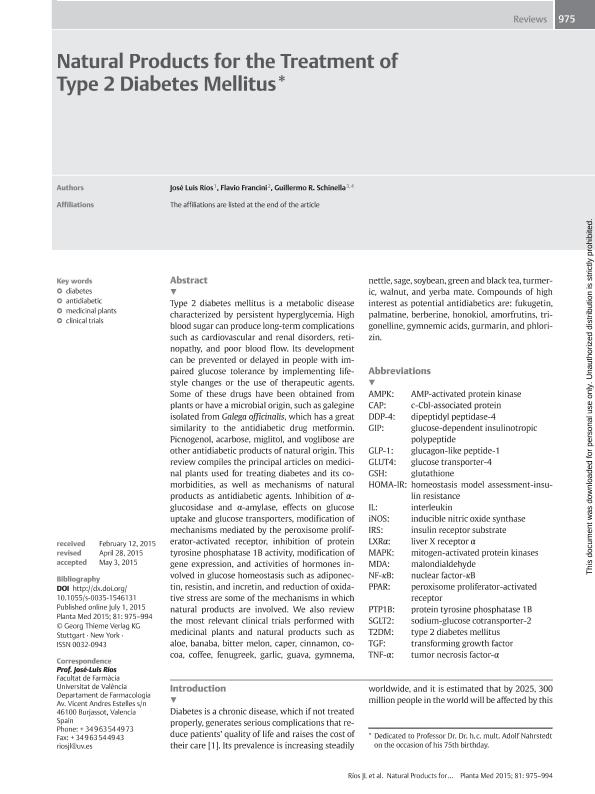Mostrar el registro sencillo del ítem
dc.contributor.author
Barrios, José Luis

dc.contributor.author
Francini, Flavio

dc.contributor.author
Schinella, Guillermo Raúl

dc.date.available
2018-06-19T21:32:38Z
dc.date.issued
2015-06
dc.identifier.citation
Barrios, José Luis; Francini, Flavio; Schinella, Guillermo Raúl; Natural products for the treatment of Type 2 Diabetes Mellitus; Georg Thieme Verlag Kg; Planta Medica; 81; 12/13; 6-2015; 975-994
dc.identifier.issn
0032-0943
dc.identifier.uri
http://hdl.handle.net/11336/49479
dc.description.abstract
Type 2 diabetes mellitus is a metabolic disease characterized by persistent hyperglycemia. High blood sugar can produce long-term complications such as cardiovascular and renal disorders, retinopathy, and poor blood flow. Its development can be prevented or delayed in people with impaired glucose tolerance by implementing lifestyle changes or the use of therapeutic agents. Some of these drugs have been obtained from plants or have a microbial origin, such as galegine isolated from Galega officinalis, which has a great similarity to the antidiabetic drug metformin. Picnogenol, acarbose, miglitol, and voglibose are other antidiabetic products of natural origin. This review compiles the principal articles on medicinal plants used for treating diabetes and its comorbidities, as well as mechanisms of natural products as antidiabetic agents. Inhibition of α-glucosidase and α-amylase, effects on glucose uptake and glucose transporters, modification of mechanisms mediated by the peroxisome proliferator-activated receptor, inhibition of protein tyrosine phosphatase 1B activity, modification of gene expression, and activities of hormones involved in glucose homeostasis such as adiponectin, resistin, and incretin, and reduction of oxidative stress are some of the mechanisms in which natural products are involved. We also review the most relevant clinical trials performed with medicinal plants and natural products such as aloe, banaba, bitter melon, caper, cinnamon, cocoa, coffee, fenugreek, garlic, guava, gymnema, nettle, sage, soybean, green and black tea, turmeric, walnut, and yerba mate. Compounds of high interest as potential antidiabetics are: fukugetin, palmatine, berberine, honokiol, amorfrutins, trigonelline, gymnemic acids, gurmarin, and phlorizin.
dc.format
application/pdf
dc.language.iso
eng
dc.publisher
Georg Thieme Verlag Kg

dc.rights
info:eu-repo/semantics/openAccess
dc.rights.uri
https://creativecommons.org/licenses/by-nc-sa/2.5/ar/
dc.subject
Diabetes Mellitus
dc.subject
Medical Plants
dc.subject
Clinical Trials
dc.subject
Antidiabetic
dc.subject.classification
Farmacología y Farmacia

dc.subject.classification
Medicina Básica

dc.subject.classification
CIENCIAS MÉDICAS Y DE LA SALUD

dc.title
Natural products for the treatment of Type 2 Diabetes Mellitus
dc.type
info:eu-repo/semantics/article
dc.type
info:ar-repo/semantics/artículo
dc.type
info:eu-repo/semantics/publishedVersion
dc.date.updated
2018-06-07T17:57:12Z
dc.journal.volume
81
dc.journal.number
12/13
dc.journal.pagination
975-994
dc.journal.pais
Alemania

dc.description.fil
Fil: Barrios, José Luis. Universidad de Valencia; España
dc.description.fil
Fil: Francini, Flavio. Consejo Nacional de Investigaciones Científicas y Técnicas. Centro Científico Tecnológico Conicet - la Plata. Centro de Endocrinología Experimental y Aplicada. Universidad Nacional de la Plata. Facultad de Cs.médicas. Centro de Endocrinología Experimental y Aplicada; Argentina
dc.description.fil
Fil: Schinella, Guillermo Raúl. Universidad Nacional de la Plata. Facultad de Ciencias Médicas; Argentina
dc.journal.title
Planta Medica

dc.relation.alternativeid
info:eu-repo/semantics/altIdentifier/url/https://www.thieme-connect.com/products/ejournals/html/10.1055/s-0035-1546131
dc.relation.alternativeid
info:eu-repo/semantics/altIdentifier/doi/http://dx.doi.org/10.1055/s-0035-1546131
dc.relation.alternativeid
info:eu-repo/semantics/altIdentifier/url/26132858
Archivos asociados
